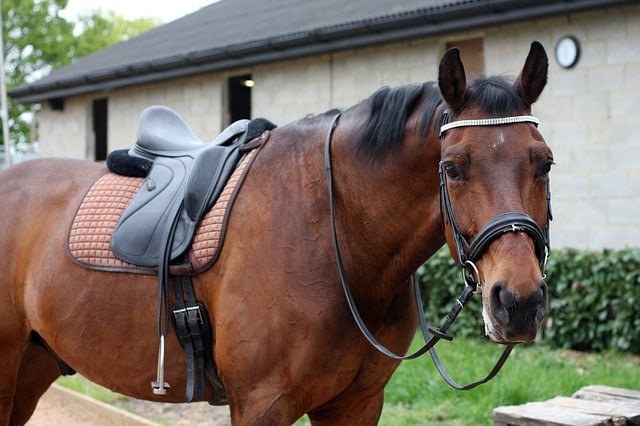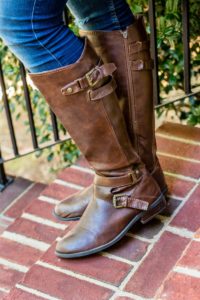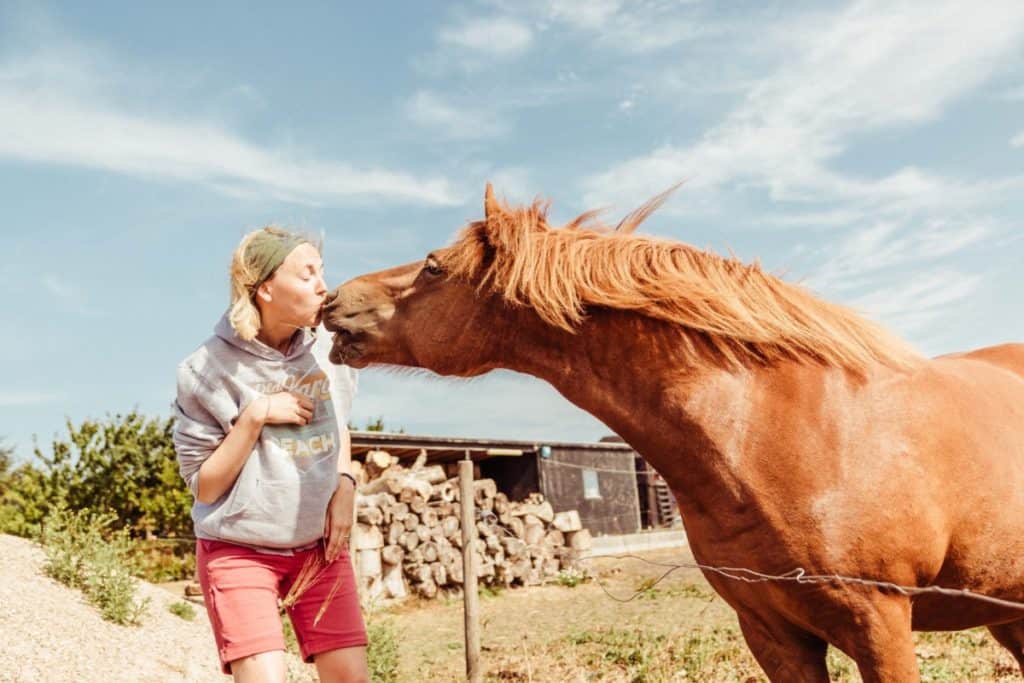
Congratulations on booking your first horse riding lesson – you are in for a treat and also a bit of a challenge! But that’s part of the fun, and in this article, we will talk through the questions people often have before their first lesson and give you some helpful tips so that you can feel better prepared for this new adventure! We’re so excited for you!
What Should I Wear to My First Horse Riding Lesson?
Generally, the first thing a prospective rider will wonder is ‘what should I wear? Do I need to buy any gear or clothing?’. The short answer is no. Most people can find something suitable in their closet or if not, will be able to borrow from the equestrian center providing the lessons or perhaps from friends or acquaintances. What we suggest you wear is the following.
Helmet
If the equestrian center you have booked with does not require you to wear a helmet we suggest you run in the opposite direction. ALWAYS wear a helmet! If you don’t have your own (and why would you when you are just starting out?), most riding schools will have some for rent or that you can borrow.
Rental helmets aren’t the most sanitary thing in the world and may not be cleaned as often as they probably should be, so if after a while you decide to stick with your classes and continue riding, we recommend buying one for yourself. Until then, surgical caps are a great and inexpensive way to create a barrier between your head and the helmet lining. Ask if the center provides those too.
Shoes
Wearing suitable footwear when horse riding is also very important for safety reasons. An appropriate pair of shoes should fulfill the following criteria:

- be ankle height (or higher)
- have a closed and protected toe (in case your horse inadvertently steps on your feet)
- have a sole that doesn’t slide around in the stirrup
- have a heel of at least 1 inch or 2.5 cm to prevent the foot from slipping through the stirrup
For these reasons, sneakers, tennis shoes are not recommended, nor any shoes with laces or large tongues as they can catch on the tack or stirrup. Hiking boots can sometimes work; however, they may in some cases be too wide for the stirrup.
If you want to know if you can wear any of the shoes you have in your closet for your riding class, check out our article Do You Need Riding Boots to Ride a Horse? What Shoes You CAN Wear.
Long Pants
You do not need breeches or jodhpurs for your first riding lesson, but you should wear long pants in a stretchy non-slippy fabric with no seams along the inner thigh area. Cotton tights or sweatpants are ok, jeans are not as they don’t have enough stretch and also have seams that will rub your legs and make your lesson very uncomfortable.
Gloves
A small piece of gear that can make a world of difference for your first riding lessons are gloves. Depending on the horse you start riding on and his behavior, wearing a pair of gloves can save you from sore skin and blisters between your fingers from the friction of the reins. Some horses may move their heads a lot or pull the reins out of your hands so protecting your hands can be a good idea.
As a bonus, in winter, gloves will help keep your hands warm and in summer protect them from the UV rays (yes, your hands can burn too!).
If you need to invest in a pair of gloves – you can read more about our top pick for riding gloves here.
Shirt
Don’t sweat too much about what shirt to wear as long as it’s comfortable. If you can, wear a long-sleeved top or at least something that covers the shoulders. Opt for something that fits quite close to your body and extends just past the top of your pants. You don’t want to wear anything that covers the bum as it will get in the way when you’re in the saddle. We love to wear shirts with a zipped front so they can be easily pulled off over a helmet if you need to peel off a layer during your ride.
Underwear
This category is not one often talked about, but ladies, it’s important. If you are a thong-loving woman, it’s time to invest in some new undies. We have suffered the consequences of thinking ‘it will be fine for just a short ride’ and the underwear literally turned into a torture device mid-ride. You have officially been warned!
Go for comfortable hipsters or briefs that are not so snug that they will get into nooks and crannies but also not so loose that they create bulges where the fabric accumulates. Lightweight and breathable fabrics are the best regardless of the season.
How do I Prepare for Horse Riding?
Besides making sure you have the appropriate gear and clothing, there are a few other things you can do to prepare yourself for your first riding class.
Work on Your Fitness
Although it may not look like it, horse riding is actually quite hard work. Once you get into the saddle and start moving you will be using muscles you rarely use for much else and we can pretty much guarantee you will be feeling it the next day. If you are not normally physically active (and even if you are), working a bit on cardio, doing some strength training and focusing on flexibility can be very beneficial for your horse riding abilities.
We enjoy doing pilates to build core strength as well as yoga to work on balance and flexibility. If you need a routine or some motivation you should check out our articles on fitness where we have included lots of targeted exercises for horse riders.
Learn Some Useful Horse Riding Jargon
If you are new to the equine world you will probably encounter a lot of new words and expressions when you go for your first riding lesson. Below we have listed some of the most common ones and that can be helpful to skim through in preparation for your class.
- Aids. This is an umbrella term for all the ways a rider can communicate with the horse while riding. It includes legs, hands, voice, whip, and spurs.
- Bridle. This is the piece of tack that goes on the horse’s head. It includes the bit in the horse’s mouth to which the reins are attached.
- Cadence. In each gait, the horse has a particular rhythm, which is referred to as cadence.
- Gait. A horse has 4 gaits; walk, trot, canter and gallop.
- Frog. When looking under a horse’s hoof, there is a softer triangular area towards the back called the frog.
- Rein in. To rein in a horse means pulling on the reins to stop the horse.
- Stirrup. The stirrup is the iron piece attached to the saddle that the rider places his feet into for balance and support.
- Tack. An umbrella term for all the equipment put on a horse before horse riding.
- Tack up. To tack up is the act of putting the tack on a horse in preparation for riding.
- Withers. Withers is the part of a horse’s neck, which is located at the bottom of the mane on the raised area just above the shoulders. When tacking up, the saddle should be placed just behind the withers. This is also the area from which the height of a horse is measured.
The video below by CRK Training explains many of the most commonly used expressions related to horses and horse riding and is a great addition to our list above. We have outlined the timestamps for the different sections below so you can watch the ones you are most interested in:
- horses (00:54 – 3:55)
- horse riding (03:55 – 5:45)
- equipment (05:45 – 06:44)
Calm Your Nerves
Are you feeling nervous about riding? Don’t worry, most riders are before their first lesson and apart from using the tips we already discussed to prepare, there are a few other things that may help you mentally prepare as well.
Learn About and Observe Horse Behavior

Often, many of the things that scare newbies about horses ultimately boil down to a lack of understanding of their behavior. And that makes complete sense – how would you understand their behavior when you haven’t spent time around them? So that’s exactly what you can do.
By dedicating a little bit of time to spend around a stable or observing horses in a field you will start creating a picture of horse behavior.
Adding to that, watching a few videos on YouTube or reading a few articles will help you build that foundational knowledge that is so helpful in dealing with these animals.
We invite you to start with 8 Tips for How to Behave Around Horses.
Plan Ahead and Arrive Early
Being in a rush increases heart rate and stress. If you are already a bit anxious about your riding class, be kind to yourself and allow for plenty of time to arrive early at the equestrian center so you have time to get familiar with the space and ambiance, have a look around, perhaps say hello to some of the other participants (if it’s a group class) so you can feel more comfortable in the space and the situation.
Go Watch Other Riding Classes
Want a little preview of what you’re in for? Ask the equestrian center if they are running other beginner classes and head there to observe one of them. Most likely you will be relieved to see that others survive their first tries and perhaps initiate a conversation with one of the participants to ask for some tips.
Bring Along a Friend
Trying something new alone can make it even more intimidating, so why not ask your friend to come along? It doesn’t necessarily have to be participating in the course itself, but knowing you have someone supporting you on the sidelines can be very reassuring and you’ll have someone to talk to about the experience afterward too.
TIP: If you bring a friend along, ask him or her to take some video footage of your class that you can watch back later. This will be so helpful in improving your posture and techniques!
What to Do on The Day of Your First Riding Lesson
Once D-day rolls around it’s time for your final preparations. Try to adjust your meals on the day so that you don’t eat or drink large quantities during the two hours preceding your riding class. This isn’t too important if you will only be riding in a walk during the class, but as soon as you advance to trot and canter, having a lot of food and beverage in your stomach can get uncomfortable and often result in a stitch in your side. If you are riding outside in the sun, don’t forget to apply SPF.
What should I bring with me?
Apart from your riding outfit, you won’t need much at all. Below are a few items that can be good to have on hand, though.
Helmet and gloves. If you have your own, make sure to bring your them along.
Means of Payment. Unless you have prepaid for the class, remember to bring means of payment. Check what payment options are available at the center before you go.

Snack for your Horse. Chances are you will want to thank your horse for the ride and what better way to do this than to offer a little snack? Some pieces of carrot or apple is usually very popular. Wait until the horse is back in his stall, don’t overdo it on the amount and ask the instructor for permission before giving the snack.
Water Bottle. Chances are you will be tired and thirsty after your riding class so having a bottle of water handy can be a good idea to get your hydration levels back up, in particular in hot weather.
An Extra Layer of Clothing. Depending on the weather and climate, you may want to bring an extra jacket or layer of clothing to put on after your ride as your body temperature comes back down.
Related Questions
Do you have to have your own horse for riding lessons? You do not need to have your own horse for riding lessons. The equestrian center you book your lesson with will provide you with a horse suited to your build, weight, and level of experience.
How long will it take to learn horse riding? As with most things, the more frequently you practice, the faster you will learn. How quickly someone can learn to ride will also depend on personal aptitude, but to fully master all gaits will likely take somewhere between 1-2 years when riding once a week.
Is riding a horse difficult? Horse riding is not particularly easy to learn. It is both physically and mentally challenging to handle both your own posture in the saddle as well as the movements of the horse. Becoming a good rider can take years depending on how often and consistently you ride.
How do I get fit for horse riding? Core and leg strength, balance and flexibility (especially hip flexibility) is key for horse riding. Pilates, yoga and targeted strength exercise for these areas are all great ways to get in shape for horse riding.
How much does it cost for horse riding lessons? How much a horse riding lesson costs will depend on whether it is an individual or group class, the quality of the instructor and equestrian center as well as your location. Expect to pay an equivalent of anything from 20 to 70 USD depending on the factors mentioned.
How often should you have horse riding lessons? How often you should take riding lessons depends on your motivation, how much time you have to dedicate to the activity, your budget, and your goals. We have found that for beginners, 2-3 classes per week typically allows for quick and steady progression without overwhelming the rider.
We hope this helped you in your preparations and hope you have an amazing first riding experience!
You May Also Like…
Is Horse Riding Easy to Learn? What you Need to Know
Approaching a Horse Correctly: The Do’s and Don’ts
Is Horse Riding Scary? Insights from an Experienced Rider
This article is accurate and true to the best of the author’s knowledge. It is not meant to substitute diagnosis, prognosis, treatment or any type of medical advice for humans or horses. Animals exhibiting signs and symptoms of distress should be seen by a veterinarian immediately.


